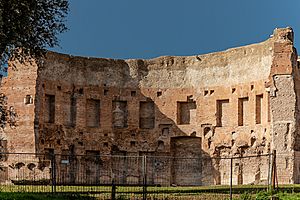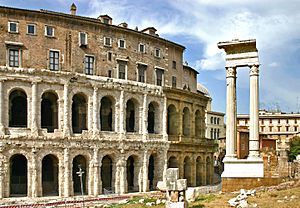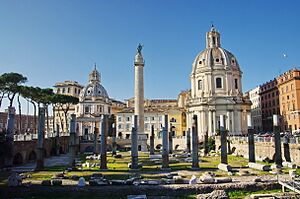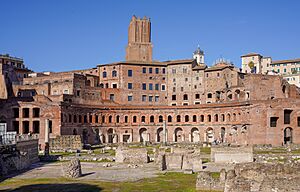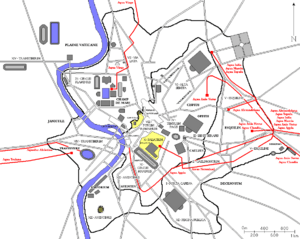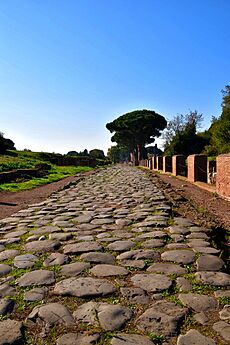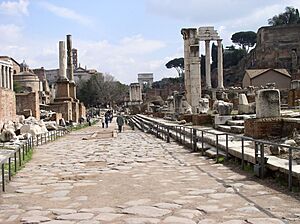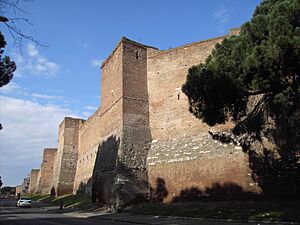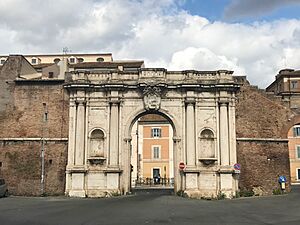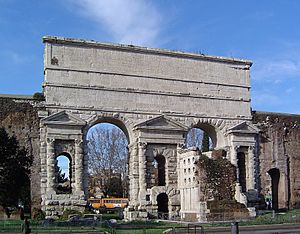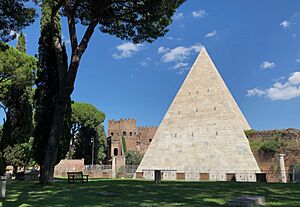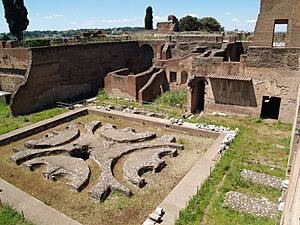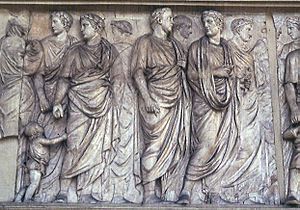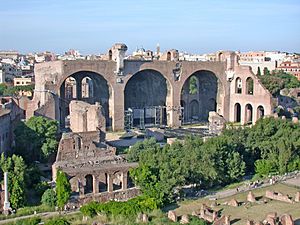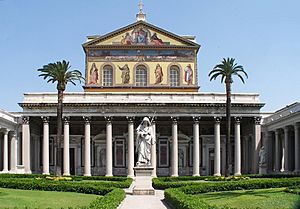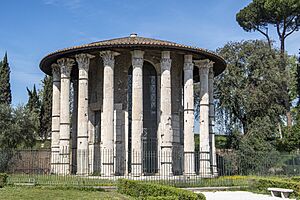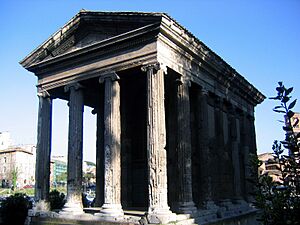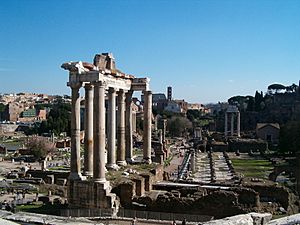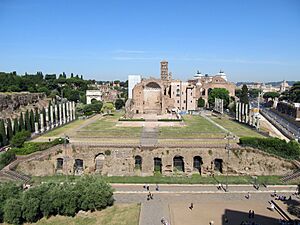List of ancient monuments in Rome facts for kids
Rome was once the center of a huge empire! Many amazing buildings and structures from the Roman Republic and Roman Empire still stand in the city of Rome, Italy. These ancient monuments tell us a lot about how people lived thousands of years ago. From giant stadiums where gladiators fought to clever water systems, these structures show the incredible skills of Roman builders.
Contents
Fun Places for Crowds
The Romans loved big shows and gatherings! They built huge places for entertainment and public life.
Amphitheaters: Gladiator Arenas
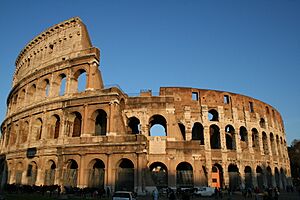
Amphitheaters were large, round or oval buildings with seats all around. They were used for exciting public events like gladiator fights, animal hunts, and even mock naval battles. The most famous one is the Colosseum!
- Amphitheatrum Castrense
- Colosseum
Baths: Roman Spas

Roman baths were more than just places to get clean. They were like community centers! People went there to bathe, exercise, socialize, read, and even eat. They had hot, warm, and cold pools.
- Baths of Caracalla
- Baths of Diocletian
- Baths of Trajan
Circuses: Chariot Race Tracks
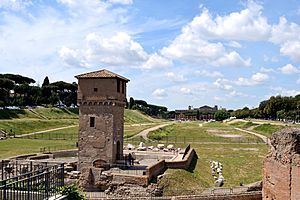
Circuses were long, oval tracks built for chariot races. These races were super popular and very exciting! The Circus Maximus was the largest, holding hundreds of thousands of spectators.
- Circus Flaminius
- Circus Maximus
- Circus of Maxentius
Theatres: Plays and Music
Roman theaters were usually semi-circular, with seats rising in tiers. They were used for plays, musical performances, and other artistic shows.
- Theatre of Balbus
- Theatre of Marcellus
- Theatre of Pompey
Other Entertainment Spots
- Ludus Magnus: This was a large training school for gladiators, right next to the Colosseum!
- Naumachia Vaticana: A special basin built for staging mock naval battles. Imagine ships fighting right there!
- Stadium of Domitian: A long, narrow stadium used for athletic contests and foot races. Today, Piazza Navona stands on its ruins.
Public Spaces and Markets
The Romans had busy public squares and markets where people met, traded, and discussed news.
Fora: City Centers

A "forum" was a public square in a Roman city. It was the heart of daily life, used for markets, meetings, speeches, and religious ceremonies. The Roman Forum was the most important one.
- Roman Forum
- Forum of Augustus
- Trajan's Forum
Markets: Places to Shop
Romans had specific markets for different goods. These were busy places where people bought food, clothes, and other necessities.
- Forum Boarium: A cattle market.
- Trajan's Market: A huge complex of shops and offices, often called the world's first shopping mall!
Amazing Infrastructure
The Romans were masters of engineering! They built incredible systems to support their large cities.
Aqueducts: Water Highways
Aqueducts were like ancient water pipes, bringing fresh water from distant sources into the city. They used gravity and clever arches to carry water over long distances, supplying baths, fountains, and homes.
- Aqua Claudia
- Aqua Marcia
- Aqua Virgo
Bridges: Crossing Rivers
Roman bridges were strong and durable, built to last for centuries. They connected different parts of the city and helped people travel across rivers.
- Pons Aelius (now Ponte Sant'Angelo)
- Pons Fabricius
- Pons Milvius (now Ponte Milvio)
Cemeteries: Resting Places

Romans buried their dead outside the city walls. Catacombs were underground burial places, often used by early Christians.
- Catacombs of Rome
- Vatican Necropolis
Roads: Paths of Power

Roman roads were incredibly well-built, connecting Rome to its vast empire. They were used by soldiers, traders, and travelers. Many are still visible today!
- Via Appia (Appian Way)
- Via Flaminia
- Via Sacra
Sewers: City Cleaners
The Romans had advanced sewer systems to remove waste from the city. The Cloaca Maxima was one of the earliest and most impressive, still partly in use today!
- Cloaca Maxima
Walls and Gates: City Defenses
Rome was protected by strong walls and gates. The Servian Wall was an early defense, later replaced and expanded by the much larger Aurelian Walls.
- Servian Wall
- Aurelian Walls
- Porta Appia
- Porta Flaminia
- Porta Praenestina
Famous Monuments
Rome is full of iconic monuments that celebrate victories, honor emperors, and mark important places.
Triumphal Arches: Victory Gates
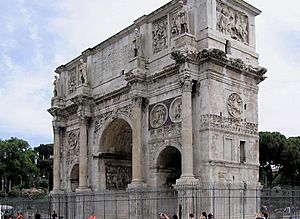
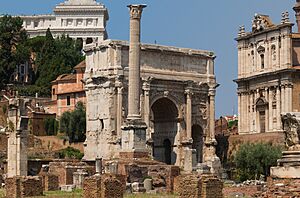
Triumphal arches were built to celebrate military victories or important events. Roman generals and emperors would march through them in parades.
- Arch of Constantine
- Arch of Septimius Severus
- Arch of Titus (Roman Forum)
Columns: Tall Tributes
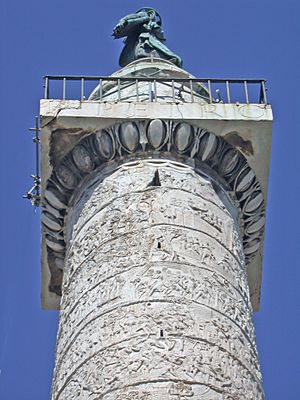
Columns were often built to honor emperors and tell stories of their military campaigns through detailed carvings that spiral up the column.
- Column of Marcus Aurelius
- Trajan's Column
Statues: Heroic Figures
Large statues were placed in public spaces to honor important people, especially emperors and gods.
- Equestrian Statue of Marcus Aurelius: A famous bronze statue of Emperor Marcus Aurelius on horseback.
Tombs and Mausoleums: Resting Places of Power

Tombs and mausoleums were built to bury important Romans, often emperors or wealthy families. Some were very grand and still stand today.
- Pyramid of Cestius: A pyramid-shaped tomb built for a wealthy Roman.
- Mausoleum of Augustus: The tomb of Rome's first emperor, Augustus.
- Mausoleum of Hadrian: Originally Emperor Hadrian's tomb, later turned into a fortress.
Obelisks: Egyptian Treasures
Obelisks are tall, four-sided stone pillars that taper to a pyramid shape at the top. Many were brought to Rome from Egypt by Roman emperors.
- Lateran Obelisk
- Flaminio Obelisk
Palaces: Homes of Emperors
The Roman emperors lived in grand palaces, mostly on the Palatine Hill. These huge homes were symbols of their power and wealth.
- Domus Aurea: Emperor Nero's massive, luxurious "Golden House."
- Palace of Domitian: A huge complex of buildings that served as the main imperial residence.
Religion and Worship
Religion was very important to the Romans. They built many temples and altars to honor their gods.
Altars: Places of Offering
Altars were structures where Romans made offerings and sacrifices to their gods.
- Altar of Augustan Peace: A beautiful altar celebrating peace under Emperor Augustus.
Basilicas: Public Halls
In ancient Rome, a basilica was a large public building, often used for law courts, business, and meetings. Many early Christian churches were later built using this design.
- Basilica Julia
- Basilica of Maxentius
- Basilica Ulpia
Early Churches: New Faith
As Christianity grew, new places of worship were built. Many of these early churches became very important.
- Basilica of Saint Paul Outside the Walls
- Basilica of St. John Lateran
- Old St. Peter's Basilica
Temples: Homes for Gods
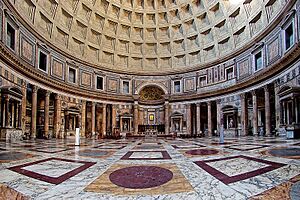
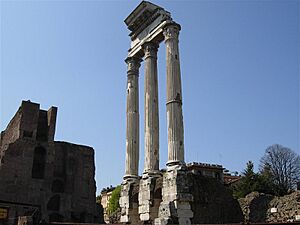
Temples were buildings dedicated to Roman gods and goddesses. People would visit them to pray and make offerings. The Pantheon is one of the best-preserved Roman temples.
- Pantheon
- Temple of Jupiter Optimus Maximus
- Temple of Apollo Sosianus
- Temple of Hercules Victor
- Temple of Portunus
- Temple of Saturn
- Temple of Venus and Roma
- Temple of Vesta
Images for kids
See also
- List of tourist attractions in Rome


